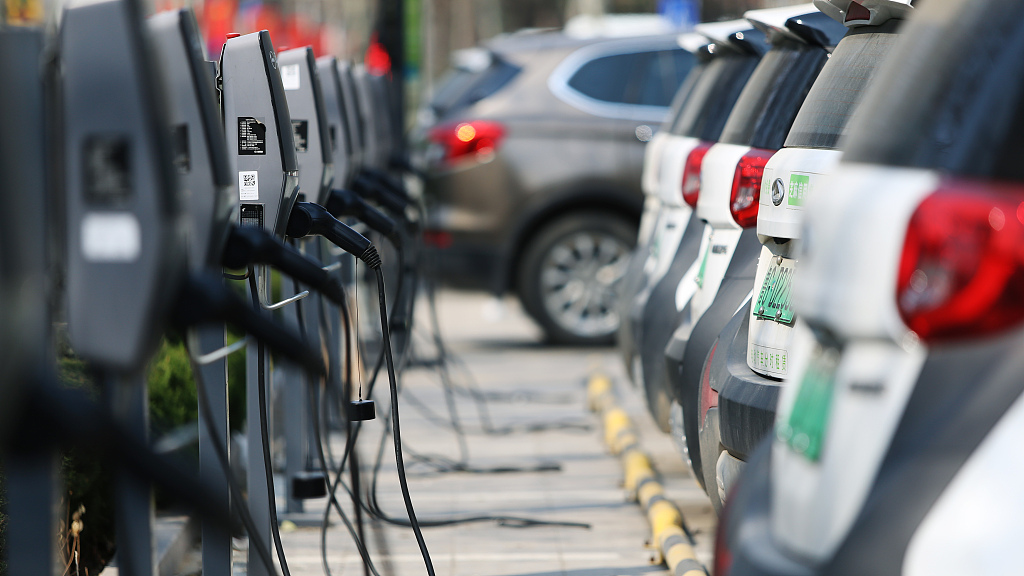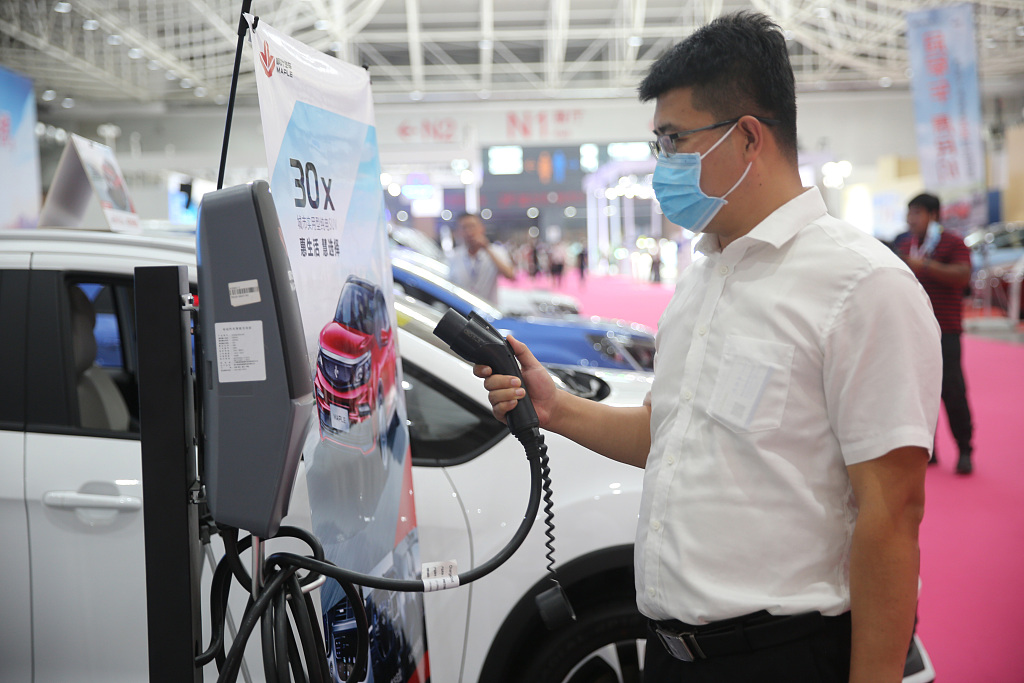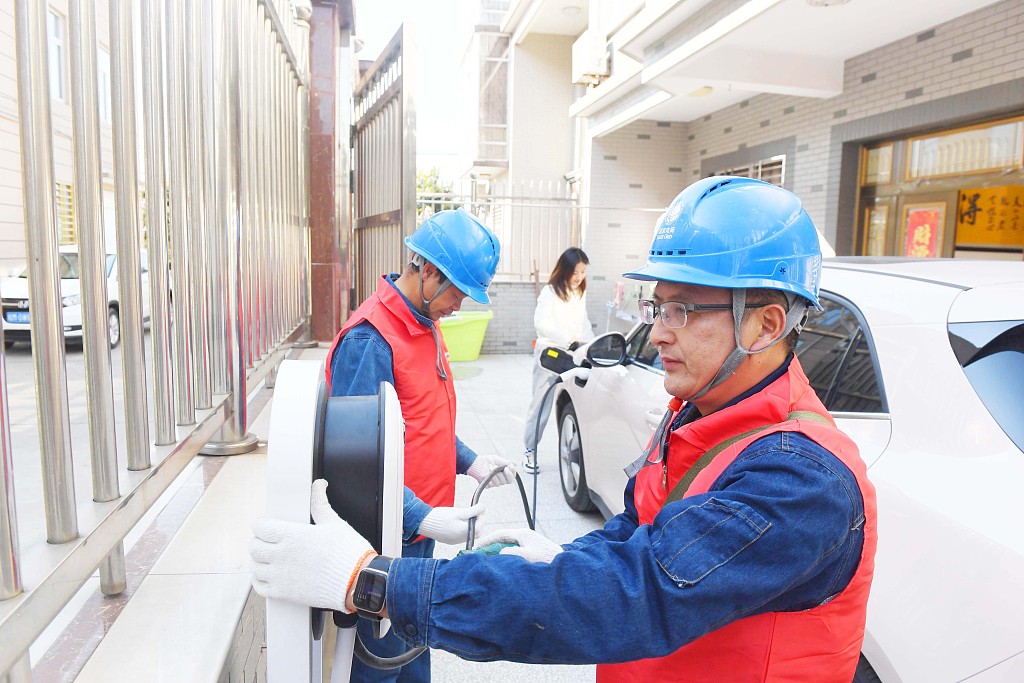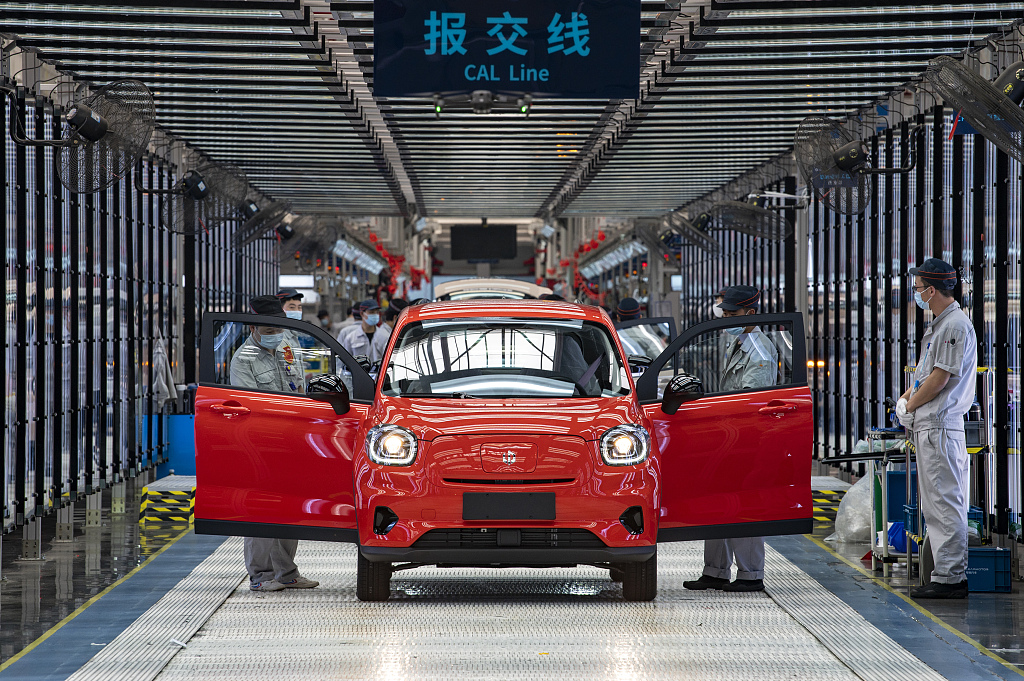01:17

Chen Shunping has been driving his plug-in hybrid for three years. He rarely uses the hybrid mode because the EV mode, which uses the battery alone, is much easier on his pocket.
"The car's battery can cover the short ranges I commute on workdays," said Chen, who lives in a village 15 kilometers away from downtown Handan, a city in north China's Hebei Province.
To reduce urban air pollution and carbon emissions, China has been promoting new energy vehicles (NEVs) for more than a decade, with implementation first starting with buses and taxis, then private cars.
In 2021, over 3.5 million NEVs have been sold in China, according to China Association of Automobile Manufacturers (CAAM), a non-profit organization based in Beijing. The sales enjoyed an increase of 1.6 times year on year, ranking first in the world for seven consecutive years.
With the government's support for the adoption of electric vehicles in rural areas in recent years, that market has become an important driving force for NEVs in China.
A campaign to open up China's rural market for NEVs first rolled out in five pilot cities in 2020 and then in eight more last year. About 20 automakers with over 50 models of electric vehicles joined the initiative each year.

A NEV charging device during a launch ceremony of a campaign to promote NEVs in rural market of Qingdao, east China's Shandong Province, July 24, 2020. /CFP
A NEV charging device during a launch ceremony of a campaign to promote NEVs in rural market of Qingdao, east China's Shandong Province, July 24, 2020. /CFP
The total sales of models selected for the promotional campaign exceeded one million in 2021, up nearly 170 percent year on year, data from CAAM shows.
"The sales growth rate of these models is higher than that of the overall NEV market, indicating that rural residents are active buyers of NEVs promoted in the campaign," said Xu Haidong, deputy chief engineer with CAAM.
Since local governments would offer special subsidies, car companies could further lower prices of these select models.
The consumption surge of NEVs in rural China has been associated to the increasing purchasing power of rural residents.
Up nearly 10 percent year on year, the per capita disposable income of China's rural residents last year is 18,931 yuan (roughly $2,900), about 40 percent of the income of urban residents, according to the National Bureau of Statistics. The income of rural residents has grown faster than that of urban residents for 12 consecutive years in China.
In some economically developed areas, rural residents prefer buying sedans as they are often seen as a symbol of social status.

Installing an electric vehicle charging pile in the yard in Zhujian Village of Chuzhou, east China's Anhui Province, February 28, 2022. /CFP
Installing an electric vehicle charging pile in the yard in Zhujian Village of Chuzhou, east China's Anhui Province, February 28, 2022. /CFP
In the past, China's rural market has been dominated by low-speed electric vehicles. The sales of these vehicles, which rarely speed pass 50 kilometers per hour, maintained a rapid growth from 2013 to 2018.
These vehicles provide practical advantages at a much cheaper price than a sedan and can be driven without a driver's license. As commutes are fairly short in small towns, the range limitation is less of a problem.
However, accidents caused by unlicensed drivers increased rapidly. During the five years of high sales growth, there have been 830,000 traffic accidents involving low-speed electric vehicles, resulting in 18,000 deaths and 186,000 injuries, according to the Traffic Administration Bureau.
In November 2018, the Chinese government stopped approving new models and investment projects of low-speed electric vehicles, and sped up drafting national standards on technical conditions for electric vehicles.
While manufacturers of the low-speed electric vehicles were being regulated, small-sized NEVs seized the opportunity to meet the market demand.
Most rural customers are sensitive to cost. Most of the NEVs selected for promotion in the rural market are sold at a price less than 150,000 yuan ($22,830).
Electric cars in the mini and small segments have been welcomed in the rural market. The Wuling Hongguang Mini EV has become one of the best-selling electric cars in China last year. The battery-powered microcar has been sold at a price from 30,000 to 50,000 yuan.
In addition to price cuts, car companies also promised to provide consumers with lifetime warranty for batteries, motors and electronic controls, free installation of charging piles and interest-free financial policies.
To expand the market, Xu said manufacturers not only need to design electric cars especially for rural consumers, but also continue to improve the service system in rural areas.
"The charging infrastructure in rural areas needs to be upgraded as well," he said.
The number of commercial and private charging piles in China had reached 3.1 million by March 2022, according to China Electric Vehicle Charging Infrastructure Promotion Alliance. On average, about three electric cars share a charging pile.
However, government subsidies are declining as the NEV market is shifting from being policy-driven to market-driven. China will withdraw all subsidies on NEVs end of this year.
Manufacturers have raised retail prices in February because of shortages of chips and batteries and the decline of subsidies. Despite the recent price surge, the sales volume of NEVs in China increased in the first quarter of 2022.
"Subsidies for A-segment NEVs are relatively low, so the decline will have little impact on the rural market," Xu said. A-segment vehicles belong to the smallest category of passenger cars which are popular among rural customers.

A workshop of Chinese electric car manufacturer Leapmotor in Jinhua, east China's Zhejiang Province, April 26, 2022. /CFP
A workshop of Chinese electric car manufacturer Leapmotor in Jinhua, east China's Zhejiang Province, April 26, 2022. /CFP
Lockdowns caused by the recent COVID-19 flare-ups in Shanghai and north China's Jilin Province also affected the auto industry as both are major hubs for auto production.
He Xiaopeng, CEO of electric vehicle maker XPeng, called for support and action from government to avoid severe loss caused by the production pause during lockdowns, through his social media posts.
Similar calls followed and they were quickly answered. Many Chinese cities have rolled out a series of measures to tackle disruptions of the auto industry supply chain.
In Chengdu, a city in southwest China's Sichuan Province, automakers are encouraged to use homegrown chips to improve the stability and competitiveness of the supply chain, according to Deng Xiaoliang, secretary general of Chengdu Automobile Industrial Ecosystem Alliance.
In east China's Ningbo, the local government formed an alliance to share manpower, logistics, and funds among automobile players to secure its automobile and auto parts industries.
But the biggest challenge is the income of rural residents, which is directly related to the state of the Chinese economy.
Xu said, "As employment and income of rural residents increase, the rural market for electric vehicles will continue to expand."
Video editor: Yang Yiren
Editor: Zeng Ziyi

